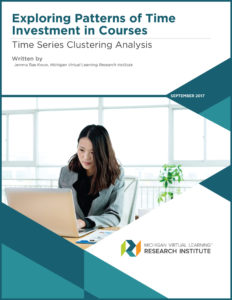ABSTRACT
 MVLRI® has launched a series of quantitative research reports exploring characteristics of students in state virtual school courses, specifically focused on those who took courses for credit recovery (CR). Using Michigan Virtual School® data, the first report provided empirical evidence related to the low performance of students whose enrollment reason was CR. The second and third reports in this series were planned to examine students’ learning behaviors in courses and thereby suggest how they engaged in the first part of an Algebra 2 course. Among the two types of behavioral indicators, namely attempted scores and the number of minutes spent in the learning management system (LMS) on a weekly basis, the current report presented results from exploring the latter, the variable of academic time. The method of time series clustering partitioned data of weekly totals of minutes in the LMS into groups based on differences or similarities among data points, and in turn generated learning profiles. Interpretations of clustering results enhance our understanding of students’ academic learning time in virtual courses and any association between the time investment pattern and learning outcomes.
MVLRI® has launched a series of quantitative research reports exploring characteristics of students in state virtual school courses, specifically focused on those who took courses for credit recovery (CR). Using Michigan Virtual School® data, the first report provided empirical evidence related to the low performance of students whose enrollment reason was CR. The second and third reports in this series were planned to examine students’ learning behaviors in courses and thereby suggest how they engaged in the first part of an Algebra 2 course. Among the two types of behavioral indicators, namely attempted scores and the number of minutes spent in the learning management system (LMS) on a weekly basis, the current report presented results from exploring the latter, the variable of academic time. The method of time series clustering partitioned data of weekly totals of minutes in the LMS into groups based on differences or similarities among data points, and in turn generated learning profiles. Interpretations of clustering results enhance our understanding of students’ academic learning time in virtual courses and any association between the time investment pattern and learning outcomes.
WRITTEN BY:
Jemma Bae Kwon, Michigan Virtual Learning Research Institute
WHAT WE ALREADY KNOW ABOUT THIS TOPIC:
- A time series analysis enables us to identify patterns among multiple attributes that might lead to a student’s success or failure and to capture key aspects of intra-individual changes in the learning process.
- By adding the clustering technique to the time series analysis, meaningful subgroups can be generated based on the similarity of time series patterns. Unique characteristics of individual subgroups and their relationships to learning outcomes inform us what types of engagement patterns throughout the semester are more likely to relate to success or failure in the course.
- To our best knowledge, no study has used this analytic approach in the context of K-12 online learning. Furthermore, there is a limitation to using the absolute value of time recorded in the LMS to explore meaningful learning profiles because we cannot always equate time-in-LMS with time-on-task. Accordingly, focusing on patterns in time series could be an alternative approach to the exploration of students’ time investments in courses.
WHAT THIS REPORT ADDS:
- For the purpose of exploring students’ academic learning time in virtual courses, we applied the new analytic approach (i.e., time series clustering) to weekly totals of minutes recorded in the LMS. The fall and spring semester (20 weeks in length) data generated the largest cluster whose members demonstrated intensive time investment during the last quarter of the academic term. Some CR students were members of this largest group for the spring semester, while others were members of the group in which considerable time was devoted to the coursework during the first half of the fall semester.
- During the short academic period of summer semester (10 weeks in length), the largest group also indicated the profile of final surge in time investments. However, the gap in cluster sizes between the largest and the second largest groups (early time investments to some degree) was reduced in comparison with the two regular semesters, suggesting that in the summer, more students attempted to devote their time to the course from the early part of the semester. Most failing CR members showed time records that were well below their cluster averages. In contrast, the passing CR members’ time investment was more likely to exceed the group averages for at least one quarter.
IMPLICATIONS FOR PRACTICE AND/OR POLICY:
One of the points we highlighted for practitioners is clustering results related to the “final surge” group for the spring and summer semesters. We found that the failing case-related percentage (i.e., the number of members from failing cases out of the total number of failing cases in the semester sample) was not proportionate to the corresponding cluster size percentage (i.e., the number of members out of the total number of cases in the semester sample). The spring’s final surge group had the cluster size percentage of 59% vs. failing case member percentage of 67%, and the summer one had the cluster size percentage of 47% vs. failing case member rate of 67%. From these results, one may deduce that relying on the abrupt increase of academic time in the final weeks of the semester is not a profile for the successful learner group in Algebra 2 courses, during the spring and summer semesters in particular. Accordingly, it is important for students to spend a significant amount of time on their courses in the early weeks of the semester. CR students specifically need to be encouraged to devote more time to the course in general.